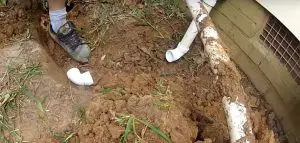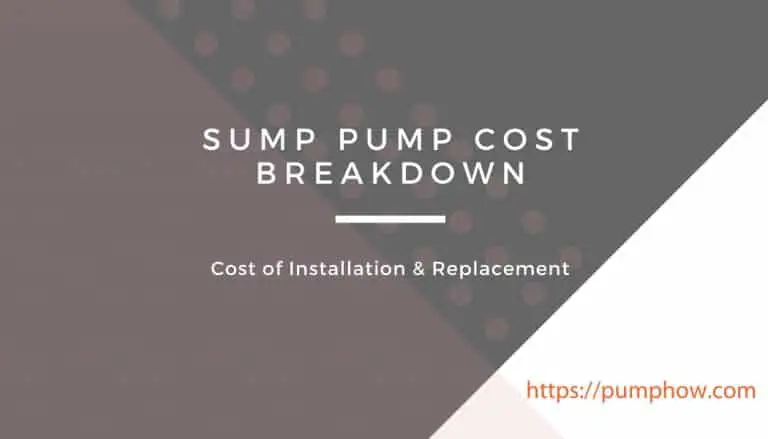Sump pumps don’t need cleaning every week or month, but eventually, you’ll have to take up the task. Are you prepared for that time when you can’t ignore it anymore?
One of the good things about these pumps is that they don’t require many parts to operate, and you won’t need to work on more than just a few things. But, that shouldn’t encourage you to forget about the right procedure.
In this article, you’ll have a complete guide that makes it easy for you and any first-timer to understand every detail associated with how to clean a sump pump.
A Step-by-Step Guide to Cleaning a Sump Pump
Instead of talking one step after another, we’ve discussed the whole thing in three different sections (the pit, the pump, and the discharge pipe/line) and arranged our suggestions accordingly.
Step 1: Getting Ready With A List of Items
You must gather the required accessories/tools before doing anything about the pump or the pit. A list of items that will find useful has been given below.
- Bucket
- Cleaning Solutions (Vinegar, Bleach, etc.)
- Gloves
- Hose
- Screwdriver
- Flashlight
- Old Blanket or Plastic Sheet (Optional)
- Plumber’s Snake
- Shop Vacuum (Wet/Dry)
Besides getting things ready, you should prepare yourself for the job. It means you need particular things to protect yourself and enjoy convenience while doing the job.
Sump basins that are older than a year may smell too foul for you. Things that drain to the pit and the health of the soil determine how bad the odor can be. Chances are you could start feeling uneasy during the task. Use a face mask to stay well when the air is filled with nauseating air.
Basements, utility rooms, or similar spaces are the places in your home where you may not have adequate lighting unless you’ve any constant/specific purpose to serve. The pit’s bottom can be too dark for your unassisted eyes to catch sight of.
In addition, most pits don’t come with a prebuilt/pre-installed lighting system. So, you should have a flashlight that provides the light as you attempt to clear the bottom.
A good practice while doing this is to make sure that the basement has got proper ventilation which helps ensure a healthy environment. Now that you’ve all you need in place, let’s get to the real job.
Step 2: Cleaning the Sump Pit
A clean sump pit may not look like a daily essential, but leaving it unclean or dirty for years causes it to become nasty, stinky, and of course too bad for you to accept.
Water that moves into a pit carries a little amount of dirt particles, otherwise known as silt. Some of these particles are drained out through the home’s discharge pipe while some may find their way in the pit’s bottom.
Once accumulated, these soil particles clog the vent/grate located on the pump’s bottom. Since water gets pulled up through that vent/grate, it may not be moved into the pump for some debris can clog the openings of the grate.
Thus, the pit is the very first thing you should care for throughout the entire cleaning job. Follow these steps to clean a sump pit.
- In many residents, a sump pit is the place where multiple systems drain to. Liquid goes down to that pit no matter if clothes or dishes are being washed. For this reason, you should keep all those utilities out of order until the job is finished. A mistake in this case might bring a disaster (deliberate basement flooding).
- Cut the power that causes the pump to run and disconnect the motor’s line from the discharge pipe. Bring the lift out of the pit too.
- Place your pump in a suitable container or a bucket. You can also wrap it in an old blanket or a plastic sheet instead. Do either of these to be able to carry the pump safely outdoors so that you don’t have to drip anything (sludge) on the carpet or the floor.
- Use the dry/wet shop vacuum to remove the water that remains in the pit.
- If you were there when the pump was installed, you might have known that two brick blocks are kept in the pit’s bottom. Get rid of them too.
- Now is the time for scraping and scooping out whatever is available of the sludge and debris. Don’t be afraid to remove them because they are perhaps the soap and detergent residues, especially if there’s a shower or washer set to drain to your sump. This is where you put the face mask on because the odor may be disturbing for your stomach.
- Once you’ve managed to clean the pit; you can replace those bricks. Then, consider reconnecting the pump to the discharge, bringing the power back to the pump. Finally, you can put the drainage systems back to the sump.
However, make sure you’ve cleaned the pump and drain pipes before doing all the restoration, and that takes us to the next step – cleaning the pump.
Step 3: Cleaning the Pump
As part of the pump’s functions, its impeller system may collect some of the debris. Because of the importance of an impeller (learn more about how a sump pump works), you can’t leave it affected by that debris. If it catches some, it may not be able to help force the water up and out with the required power. Eventually, water may have its way back into the pit.
The float may also get affected by debris which may cause the part to stick or become inactive. It may not trigger the pump’s action when the water goes up.
Cleaning the pump and its components is easy only when you know your way around them. You can use mild acid (vinegar is preferable to others). Apply the solution to the surface and parts and allow them to sit for a while (5-10 minutes). That acid helps loosen the debris, and once it does; wash them properly.
Attention
Hold your pump by its body or handle while removing it from the sump pit. Don’t lift it by its power cord or float switch for they may break.
Step 4: Cleaning Sump Pump Drain Pipes

Drain pipes through which the pumped water is moved out don’t usually get much attention. Clogged pipes aren’t good for your pump and the entire ‘basement waterproofing’ thing. So, you can’t simply ignore it.
- Start by removing the cover/screen installed at the pipe’s end. If you can’t identify the end, look outside the home to discover a pipe that drains on a downslope moving away from your house. The cover may collect debris/dirt. Rinse it off thoroughly to remove them.
- Sometimes, the drain pipe may not have a screen. If that’s the case, you can move past this step. However, try to bring one and use it after the cleaning is completed.
- Check the drainage pipe to see if there’s any visible blockage. If there is, remove it immediately.
- A clamp holds the pipe in its place. Loosen that and remove the pipe carefully.
- Use the plumber’s snake to reach the pipe’s end that connects it to your pump. Push that snake all the way through to the pipe’s other end.
- Try to hold the drain pipe vertically over a sink or bucket. Spray water slowly down that pipe. You can use a regular garden hose. A high-pressure nozzle can be helpful for the task if the snake can’t remove the blockage.
- Run the snake carefully through the pipe to remove the material that may still stay inside the pipe’s wall.
- Spray normal water into the drain pipe once again so that the remaining dirt/debris can be removed properly.
Step 5: Finishing off the Process
As you’re already past the cleaning phase, you should be thinking about putting everything in the place, and that starts with repositioning the pump in the pit. Some homeowners don’t pay much attention to the float’s positioning and movement. But, it’s important. After having it set, check to see if it moves freely. A stuck float is no better than a broken one.
Attach the drain/discharge pipe to your sump pump gently. Then, tighten the clamp that keeps the pipe in place. Don’t overdo it. Insert the pump into the sump pit. Reconnect all systems, connections, and the power too.
Finally, turn your pump on, pour some water into your sump pit. These actions are meant to help you see if things are okay. So, you may not deem them as necessary if you’re sure no mistakes have been made along the way.
Attention
Be careful about what pumping. Avoid petroleum substances, alcohol, extremely acidic materials, flammable items, or such particles at any rate. Try not to allow solids, sand, and anything that doesn’t usually dissolve in water. Particles that dissolve in water quickly or eventually aren’t much of a problem.
How Often Should You Clean A Sump Pump?
Some plumbers suggest that the pump or certain parts of it be cleaned once or twice a year while others emphasize on the fact that it should be cleaned once a while, especially after a major flood or if the sump pit is connected to different utilities. For peace of mind, you can follow the schedules explained below.
Some pumps are installed in a way that they can dispose of the liquids coming from washing machines or similar appliances. If yours is one of those busy pumps, you should choose to clean the inlet opening or pump’s screen (not essentially the pump) once a month.
If your pump isn’t required to pump water from other appliances, you can clean the screen or the inlet opening 3-4 times throughout the year. An annual job is good when it comes to the entire system. However, you may need to do it all one more time if your area receives heavy downpours.
Which Cleaning Material to Choose: Vinegar or Bleach?
Vinegar is the most popular cleaning agent for sump pumps. It’s actually a mild acid widely used as a food source, cleaning solution, and pesticide. Containing acidic properties, it dissolves common residues from surfaces made of epoxy resin or stainless steel.
Kitchen vinegar may not be effective enough. So, you want to have a stronger type. Water should be mixed with vinegar to prevent it from damaging parts of your sump pump. Follow a 1:2 ratio (vinegar: 1 gallon; water: 2 gallons).
Using bleach isn’t exactly what you choose for the cleaning purpose only. It’s a great disinfectant, which is why, it can still be considered as a part of the job. Sump pumps may get dry due to long dry spells, and certain gases may be released inside to create odor. Bleach can be a quick solution.
If the trap is empty and without water, you can pour water diluted with bleach into it. One cup of bleach should be diluted in one gallon of water. This much should be sufficient to wash the drain lines and pipes.
If you see there’s water inside, which is very conducive to the growth of bacteria, mildew, etc., you should use the same solution (water diluted with bleach) until the passage of the dry spell and initialization of water circulation.
If the odor doesn’t go away, you should do some cleaning once again, but only the trap and the pipes will be okay this time.
So, you see it’s neither complicated nor challenging. Find the essentials and finish it in less than a couple of hours. Yet, you shouldn’t go for it if you can’t figure out how to disconnect the different residential systems that use the sump pit for water drainage.
You can invite a plumbing pro and get it done, but there’s a cost involved, which is anywhere between $100 and $200 if you don’t need to replace any important part except the screen.
Final Words
As you’re done with reading our guide, we can only hope that you won’t have any difficulty carrying it out. Despite we appreciate your queries or messages for further help with the topic.





